New Acoustical Options in Specialty and Seamless Ceiling Systems
Workplace Environments
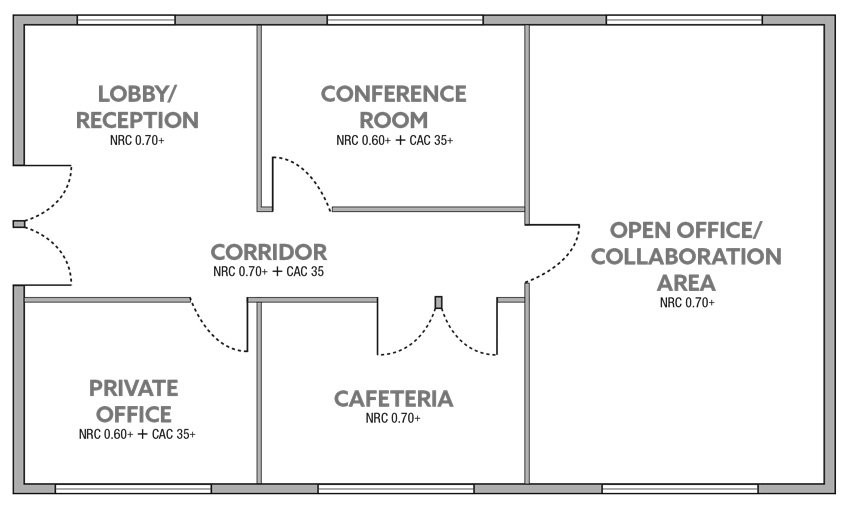
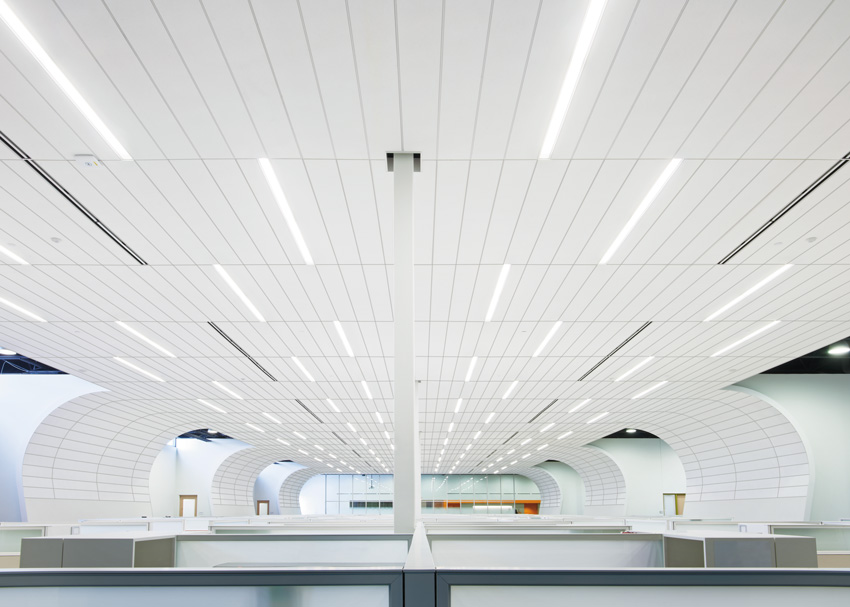
Good acoustic design in today’s office or workplace environments addresses both rooms for quiet concentration and spaces for energetic collaboration. Locations where speech privacy is required, such as a private office or small conference room, need strong sound absorption and sound blocking for good all-around acoustical performance. Designing these rooms with ceilings that achieve NRC values of 0.70 or higher and a CAC value of at least 35 provides the highest level of acoustical privacy and performance. On the other hand, open collaboration spaces need strong sound absorption and sound blocking to prevent undue sound reverberations and transfer of sound to adjacent spaces. Acoustical ceiling treatments with NRC values of 0.70 work for spaces where this is a priority. Spaces where less sound absorption is required but sound blocking is needed to maintain privacy between adjacent areas can use products with somewhat lower NRC values on the order of 0.60–0.65.
Health-Care Environments
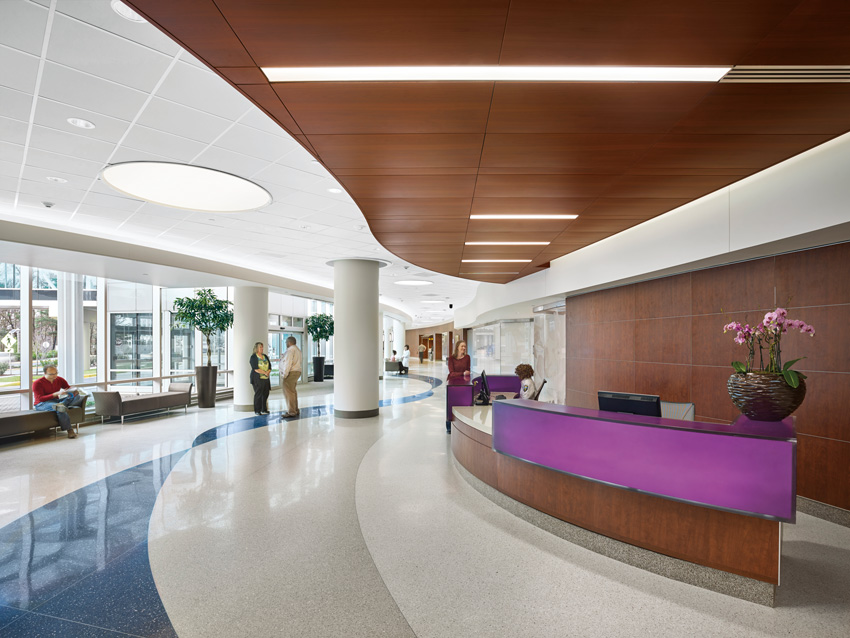
Health-care environments are most successful when they are designed to create a calming atmosphere that may also connect patients with nature. Therefore, good acoustic design in health-care environments must address the need for quiet spaces for healing while also addressing the other often active work and public spaces in the building. Spaces with excessive noise, such as in corridors, busy nurses’ stations, and chaotic treatment rooms negatively affect patients, but they also hamper interactions between health-care professionals and staff. Therefore, spaces dedicated to patient healing require superior sound absorption and sound blocking in order to help keep noise levels down and prevent disruption from adjacent spaces. These spaces should have ceilings with an NRC value of at least 0.70 and a CAC value of 35 or higher. Other areas, such as nurses’ stations, where private conversations and critical information transfer take place should have high-absorption ceilings that keep RT levels down to help with background noise leakage and speech intelligibility. Ceilings with a NRC of at least 0.70 are best for this type of environment. Similarly, public spaces in health-care settings should have ceilings with an NRC of at least 0.80.
Educational Environments
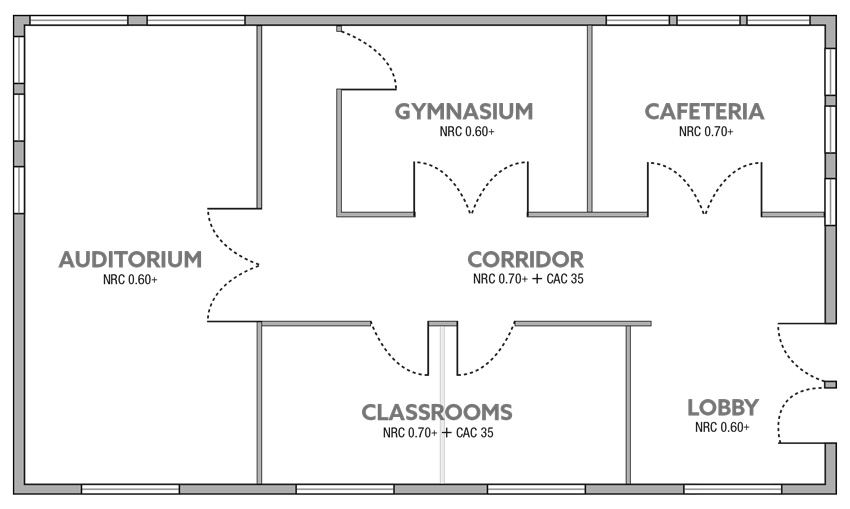
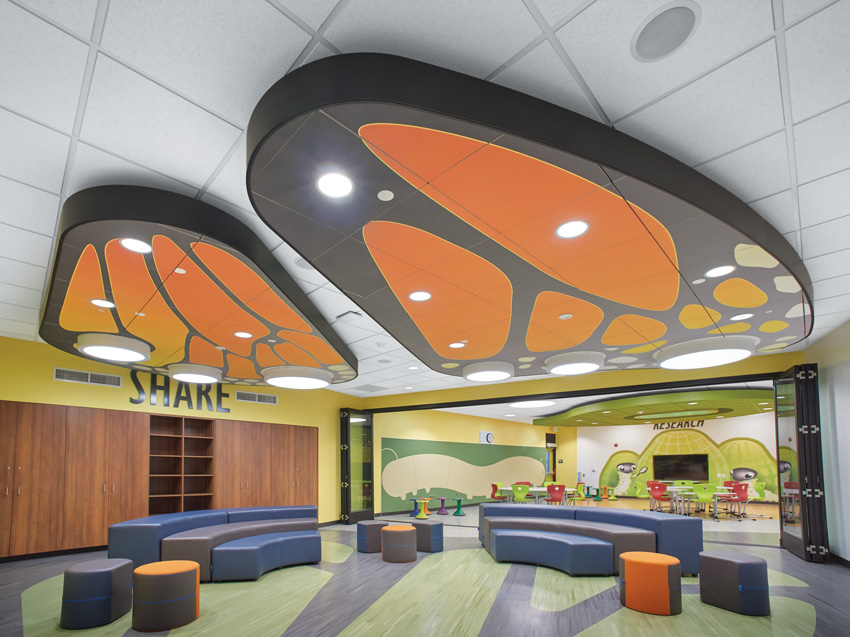
Good acoustical design in education spaces promotes high speech intelligibility for understanding, learning, and effective collaboration. Excessive reverberation inhibits student understanding and increases teacher vocal strain. Studies indicate that students typically hear only three out of every four words in the classroom, missing 25 percent of what is said. This issue can be addressed by meeting the recommended reverberation time for instructional spaces at 0.6 seconds using high-performing ceilings with NRC values of 0.70 or higher.
It is popular to design open, multipurpose spaces in many schools that may change from cafeterias to auditoriums to gymnasiums depending on the daily need. However, each of these uses require different acoustical performance in order to be effective. Sound absorption is key in this situation and can be accomplished with ceilings that obtain high NRC values—specifically, NRC values should not be lower than 0.60 in these types of spaces. If sound transmission to adjacent spaces is a concern, then selecting treatments with an NRC 0.70 and a CAC of 35 or higher is recommended.
With all of the foregoing as a basis for acoustical performance, let’s now turn our attention to the other design aspects of ceilings. Specifically, we will look at some of the innovative and appealing ceiling types that provide both great design options and acoustical performance. We will also look briefly at their sustainability characteristics and examine their use through case study examples.
Specialty Acoustical Ceiling Tile
Most design professionals are accustomed to the familiar suspended, white-colored acoustical ceiling tile systems that have been common in many 2-by-4-foot and 2-by-2-foot patterns for years. These are no longer the only good acoustic choices. Instead, there are new panel shapes and colors available that can be combined into innovative geometric ceiling patterns to create or enhance exceptional design schemes. Different sizes and shapes can be combined in different patterns and colors (both bold and subtle) using special installation components that accommodate creative freedom. Further, lighting and HVAC diffusers have become available through certain manufacturers that coordinate and fit into a variety of alternative patterns, including narrow linear, triangular, and other shapes. These new panels may be used as insets or borders in additional to full ceiling installations.
The acoustical properties of these specialty tile systems are comparable to the acoustical properties of conventional acoustical ceiling tiles in that they can vary based on the product selected. Nonetheless, manufacturers do provide a range of choices in this regard too, so it’s likely that a particular design and acoustical performance criteria can be matched up. At least one manufacturer helps narrow down the selection process by indicating categories of performance as “best, better, and good.”
Specialty acoustical ceiling tiles meet many other typical performance needs too. Attributes and characteristics related to building concerns such as fire ratings, light reflectance, and seismic resistance are readily obtained and can be specified accordingly. From an operations standpoint, they also provide characteristics related to durability, cleanability, mold/mildew resistance, and humidity/sag resistance. Many of these play directly into the sustainability attributes of such ceilings, as does the use of recycled content, and materials that are listed in environmental and health product declarations. Accordingly, many of these specialty ceiling tile systems can contribute to green building programs, such as LEED, Living Building Challenge (Declare), and Well Building Standard.









